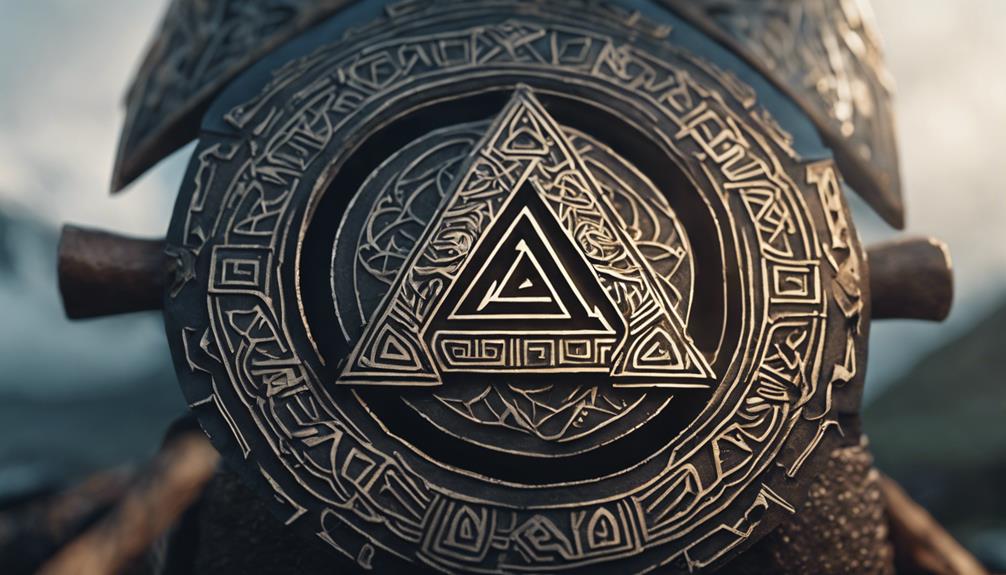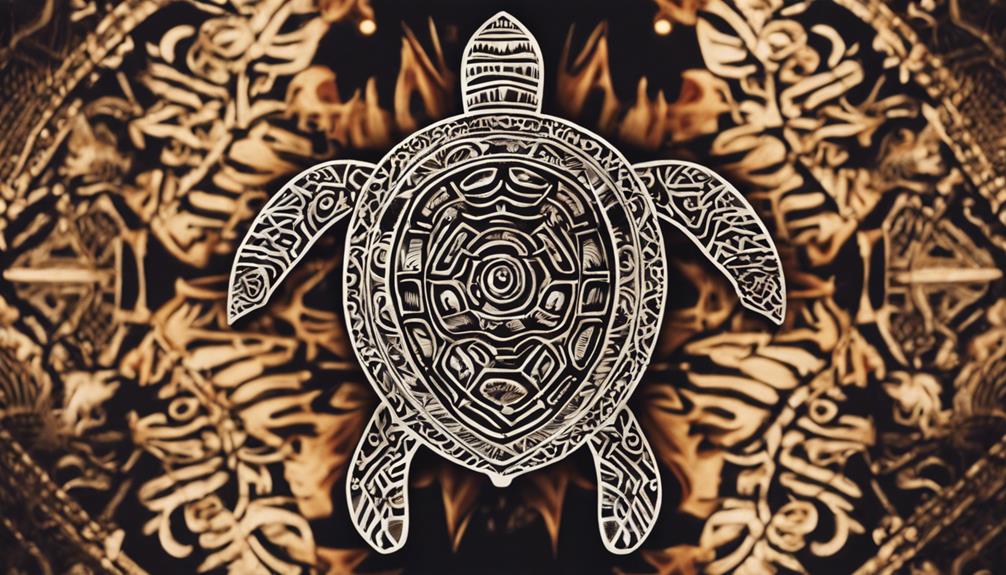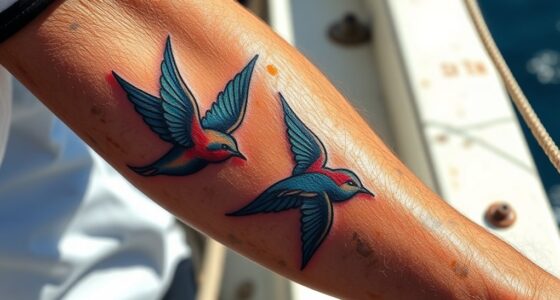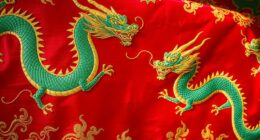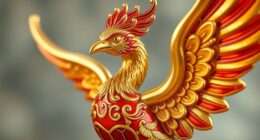Join us as we reveal the meanings behind the top 10 Viking symbols. Thor's Hammer, Mjolnir, represents power and courage. The Valknut symbolizes life, death, and destiny's interconnectedness. Helm of Awe, Aegishjalmur, embodies protection and bravery. Norse Compass, Vegvisir, guides in uncertain times. Yggdrasil, the World Tree, symbolizes life's cycle. Gungnir, Odin's Spear, signifies victory and inspiration. The Swastika brings prosperity and protection. Web of Wyrd represents fate's tapestry. In conclusion, the Troll Cross wards off evil. Discover the ancient world of Norse mythology through these powerful symbols hinting at rich cultural significance.
Key Takeaways
- Thor's Hammer symbolizes strength and protection, crafted by dwarven artisans.
- Valknut symbolizes life, death, and destiny interconnectedness, embodying warrior spirit.
- Helm of Awe signifies courage and protection for Viking warriors, instilling fearlessness.
- Yggdrasil, the World Tree, symbolizes cosmic beliefs, connecting nine worlds in Norse universe.
- Norse Compass (Vegvisir) guides and protects travelers, aiding in finding life's path.
Thor's Hammer – Mjolnir
Crafted by skilled dwarven craftsmen, Mjolnir, also known as Thor's Hammer, embodies the essence of thunder, lightning, and protection within Viking culture. This iconic symbol not only represents the power of Thor but also serves as a talisman of strength and courage for warriors. Worn for its protective qualities, Mjolnir was believed to offer blessings of fertility and consecration to those who carried it into battle. The intricate design and magical properties of Thor's Hammer made it a revered artifact among the Vikings, symbolizing not only physical protection but also spiritual fortitude.
Despite the Viking conversion to Christianity, Mjolnir retained its significance as a symbol of heritage and resilience. The enduring popularity of Thor's Hammer showcases its timeless appeal and the deep-rooted connection that Viking culture had with the forces of nature and divine protection. As we explore the world of Viking symbols, Mjolnir stands out as a beacon of strength and guardianship, embodying the warrior spirit of the Norse people.
The Valknut Symbol
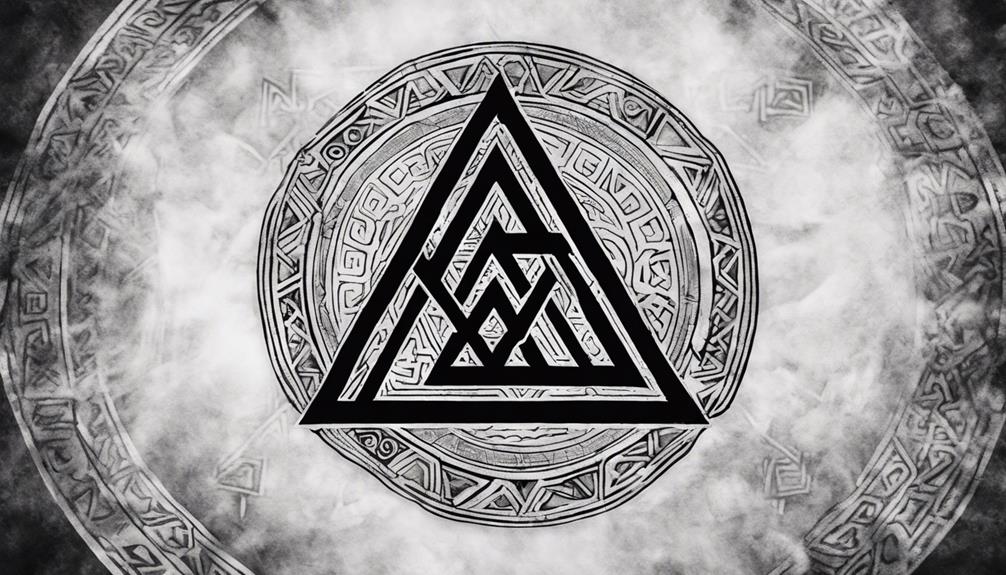
Symbolizing the interconnectedness of life, death, and destiny, the Valknut symbol is closely associated with Odin and the fallen warriors in Valhalla. Here are some intriguing facts about the Valknut symbol:
- The Valknut symbol, with its three interlocking triangles, is a powerful emblem found on Viking artifacts and runestones.
- It represents the shift between life and death, illustrating the cyclical nature of existence.
- Linked to Odin as the chooser of the slain, the Valknut symbol underscores his role in the afterlife in Norse mythology.
- Embodying protection, strength, and honor, the Valknut symbol captures the warrior spirit revered in Viking culture.
The Valknut symbol's deep-rooted connections to Odin and the concepts of life and death make it a symbol rich in meaning and significance in Viking lore.
Helm of Awe – Aegishjalmur

The Helm of Awe, known as Aegishjalmur, serves as a formidable protective symbol revered by Vikings for its ability to instill courage and induce fear in adversaries. This Norse symbol was believed to offer protection to Viking warriors in battles, helping them overcome challenges and emerge victorious. The Helm of Awe is often depicted as a circular design with radiating arms or spikes, symbolizing strength and intimidation to enemies. It embodies the bravery and resilience of the wearer, instilling a sense of fearlessness in the face of danger.
To better visualize the Helm of Awe symbol, here is a table showcasing its distinct characteristics:
| Aspect | Description |
|---|---|
| Symbol Name | Helm of Awe |
| Alternative Name | Aegishjalmur |
| Meaning | Protection and courage |
| Depiction | Circular design with radiating arms |
| Usage | Worn by Viking warriors for protection |
The Helm of Awe symbolizes the protective essence that Vikings sought during their conquests, embodying the strength and valor necessary for triumph in battle.
Norse Compass – Vegvisir
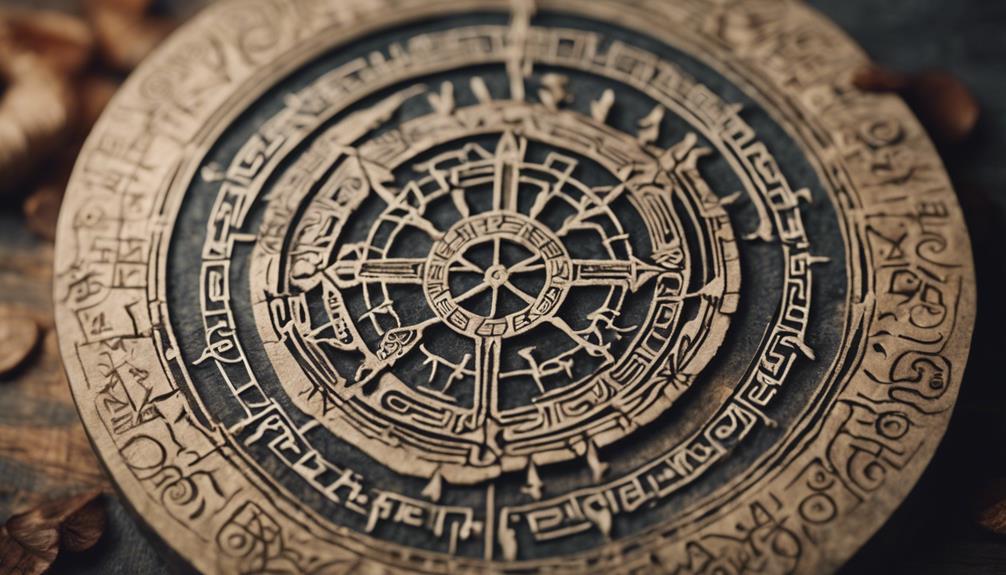
Vegvisir is a symbol of protection, guiding travelers through rough seas or unfamiliar lands. Its intricate design reflects the importance of safe navigation and spiritual guidance.
Understanding the historical significance of this Norse compass sheds light on its enduring relevance in modern times.
Vegvisir Protection Symbol
In times of uncertainty, when guidance is needed the most, the Norse Compass, also known as the Vegvisir, serves as a powerful symbol of protection and direction for Vikings. The Vegvisir symbolizes safe travels physically and spiritually, ensuring a safe return home. This ancient symbol is believed to help individuals find their way even when lost or facing challenges. Its association with navigation and life's journey makes it a prominent Viking symbol embodying protection and direction in times of need.
- Provides guidance in uncertain times
- Symbol of protection for travelers
- Offers spiritual reassurance
- Aids in finding one's path in life
Navigation and Guidance
When seeking direction and guidance in challenging situations, the Norse Compass, also known as Vegvisir, stands as a steadfast symbol of protection and direction for Vikings.
The Vegvisir symbolizes the wayfinding abilities of the ancient Norse seafarers, aiding them in steering through treacherous waters and unfamiliar territories. Its intricate design, featuring eight rune staves radiating from a central point, is believed to guide travelers safely to their destinations.
Vikings carried Vegvisir with them on their journeys, counting on its magical properties to make sure they stayed on course and avoided getting lost. This symbol not only represents physical direction but also serves as a metaphor for guiding individuals through life's challenges, offering a sense of security and direction in times of uncertainty.
Historical Significance of Vegvisir
Exploring the annals of Viking history uncovers the profound impact of the Norse Compass, known as Vegvisir, on the seafaring culture of the ancient Norse people. The Vegvisir, a symbol of wayfinding and protection, holds significant historical importance:
- The Vegvisir, a Viking symbol for wayfinding and spiritual guidance, aids travelers in finding their way home.
- Depicted as an eight-armed symbol, it helps individuals navigate even when they lose their path.
- Mentioned in the Huld Manuscript, the Vegvisir is associated with protection during journeys.
- It symbolizes the ability to navigate through life's challenges and find one's true direction.
Yggdrasil – World Tree

Yggdrasil, the World Tree in Norse mythology, is a powerful symbol that connects the nine worlds of the Nordic universe. It embodies creation, life, and fate, making it a central element in Viking cosmology.
Depicted as a massive ash tree with roots reaching into different worlds, Yggdrasil's name, translating to 'Odin's horse,' highlights its significance to the Allfather.
Yggdrasil Symbolism Explained
In Norse mythology, the World Tree known as Yggdrasil serves as an important link connecting the nine domains of the Nordic universe.
Yggdrasil symbolizes creation, life, and fate in Viking cosmology.
It represents the cycle of life, harmony, and interconnectedness.
This immense ash tree is intertwined with mythical creatures and gods.
The name Yggdrasil, meaning 'horse of Odin,' highlights its significance in Viking beliefs.
Mythical Roots of Yggdrasil
Intertwined with the fabric of Viking cosmology and Norse mythology, the roots of Yggdrasil penetrate deep into the spiritual and cosmic beliefs of the ancient Nordic world. Yggdrasil, known as the World Tree, serves as a crucial link connecting the nine worlds of Norse mythology.
Symbolizing the cycle of life, creation, and fate, this mystical tree holds a central place in Viking cosmology. It's closely tied to mythical creatures and gods, with Odin, the All-Father, being one of its prominent associations. The name 'Yggdrasil,' meaning 'horse of Odin,' underscores its significance in Viking beliefs.
Despite rare depictions from the Viking age, representations of Yggdrasil offer valuable insights into the spiritual and cosmic ideologies of the Norse people.
Symbolic Representation in Art
How does the symbolic representation of the World Tree in Viking art convey the interconnectedness of the nine domains in Norse mythology?
The intricate depictions of Yggdrasil in Viking art serve as a visual reminder of the profound link between the domains of gods, humans, and monsters. Through the artistic portrayal of Yggdrasil, Vikings highlighted the harmonious connection that binds the nine worlds together, emphasizing the cyclical nature of existence and the balance within the cosmos.
In Viking art, Yggdrasil symbolizes more than just a tree; it represents the very essence of life, death, and the eternal cycle. The artistic renditions of Yggdrasil on artifacts like the Överhogdal tapestries showcase the deep-rooted significance of this cosmic tree in Viking beliefs and culture.
- Yggdrasil's intricate details convey the interconnectedness of the nine worlds
- Viking art highlights the harmonious link between gods, humans, and monsters
- Depictions of Yggdrasil emphasize the cyclical nature of existence
- Artistic representations on artifacts like the Överhogdal tapestries showcase the tree's significance
Svefnthorn Symbol
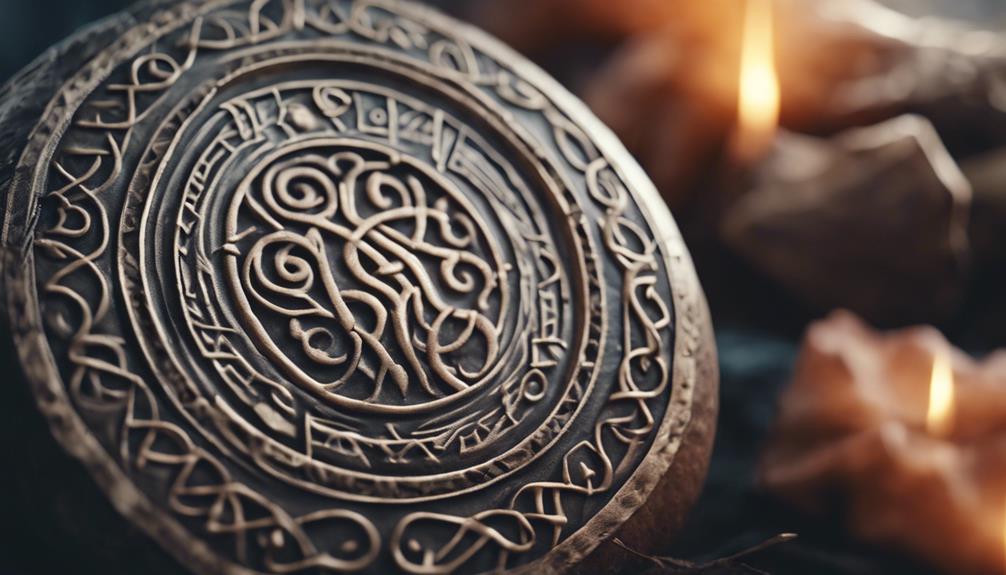
Inducing deep sleep or incapacitating adversaries, the Svefnthorn symbol was highly regarded in Viking culture for its protective and magical properties. This Viking symbol, associated with Odin, was believed to hold mystical powers that safeguarded individuals from harm. Utilized in Norse mythology by Odin himself to lull a Valkyrie into a deep slumber, the Svefnthorn symbol was revered for its ability to ward off danger and provide a shield against malevolent forces.
In Viking sagas and folklore, tales abound of the Svefnthorn's efficacy in keeping individuals safe from harm. Whether carved into objects or depicted in various forms, this symbol was a potent emblem of protection in Viking society. Its intricate design and rich history made it a sought-after symbol for those seeking safety and security in a world fraught with peril.
The Svefnthorn symbol stands as a tribute to the Vikings' belief in the power of magic and protection, showcasing their reverence for symbols that could shield them from harm.
Gungnir – Odin's Spear
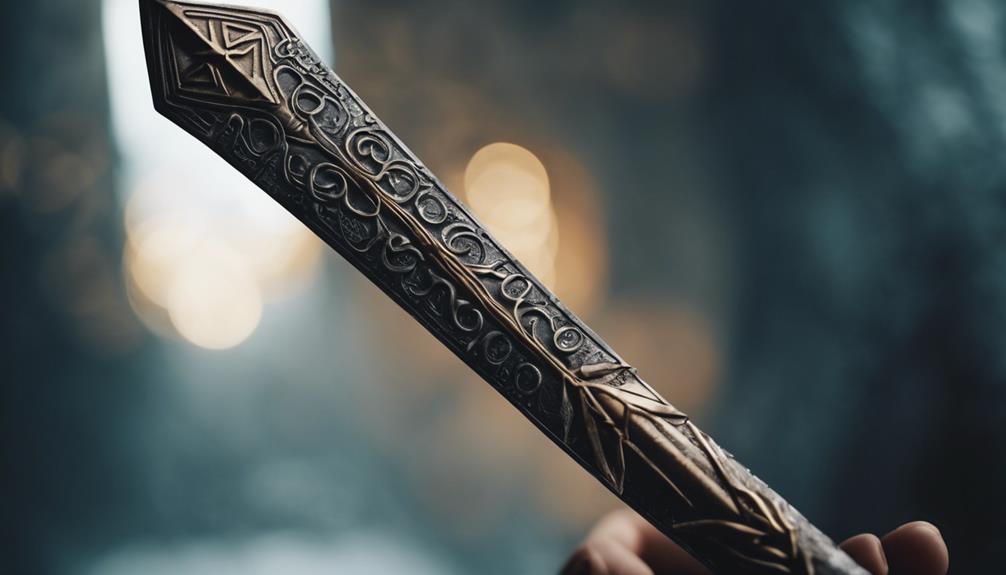
Gungnir, Odin's legendary spear, holds immense significance in Norse mythology as a powerful symbol of war and victory. Crafted with magical runes by skilled dwarven artisans, Gungnir represents divine protection and Odin's strategic prowess in battles.
Its unerring accuracy and mystical properties highlight the spear's role in shaping Odin's status as a wise and formidable deity among the Norse pantheon.
Powerful Symbol of War
Crafted by skilled dwarven craftsmen using magical runes, Odin's spear, Gungnir, embodies the essence of war and courage in Viking culture.
- Gungnir, a symbol of victory in battles
- Represents the warrior spirit of the Norse mythology
- Offers divine protection to those who wield it
- Signifies Odin's strength and inspiration in warfare
The design and craftsmanship of Gungnir not only reflect the power and determination of the warrior wielding it but also carry a sense of ancient mystique that captivates the imagination. As a potent symbol of war, Gungnir stands as proof of the Viking belief in the connection between divine wisdom, military prowess, and the courage needed to face any challenge head-on.
Linked to Victory
Symbolizing triumph and valor in battle, Odin's spear, Gungnir, stands as a symbol of the Viking warriors' unwavering spirit and determination. Crafted by skilled dwarven smiths with powerful runes, Gungnir embodies victory, inspiration, and courage in the heat of combat.
This legendary weapon, wielded by Odin, the Allfather himself, is renowned for its unerring aim, never failing to strike its intended target. As a symbol of Odin's quest for wisdom and triumph over his foes, Gungnir holds a significant place in Norse mythology, representing authority and power.
The spear's essence captures the warrior spirit of the Norse people, reflecting their relentless pursuit of excellence in battle and their unwavering commitment to achieving victory on the battlefield.
Represents Divine Protection
Representing divine protection in Viking mythology, Odin's spear, Gungnir, embodies courage and inspiration on the battlefield.
- Crafted by skilled dwarven artisans with magical runes, Gungnir was a formidable weapon wielded by Odin himself.
- The spear's association with Odin's wisdom-seeking journeys and victorious battles enhances its significance as a symbol of divine protection.
- Gungnir's mystical properties and its link to Odin's leadership make it a revered emblem in Viking culture.
- The power and symbolism of Gungnir underscore its role as a potent representation of divine protection and strength in the Viking world.
Swastika Symbol

The swastika symbol holds a deep-rooted significance in Viking culture, symbolizing prosperity, power, and protection. In Norse beliefs, it was a positive symbol associated with luck and well-being. Vikings used the swastika as a representation of good fortune on various artifacts, highlighting its importance in their society.
The swastika's original meaning as a symbol of positivity and prosperity contrasts sharply with its later association with the Nazis. To truly grasp the essence of the swastika in Viking culture, it's important to explore into its historical context. By understanding its roots as a symbol of protection and power in Norse traditions, we can appreciate its original intent before its unfortunate misuse.
The swastika serves as a reminder of the complexities of symbols and the importance of recognizing their diverse meanings across different cultures and time periods.
Web of Wyrd Emblem
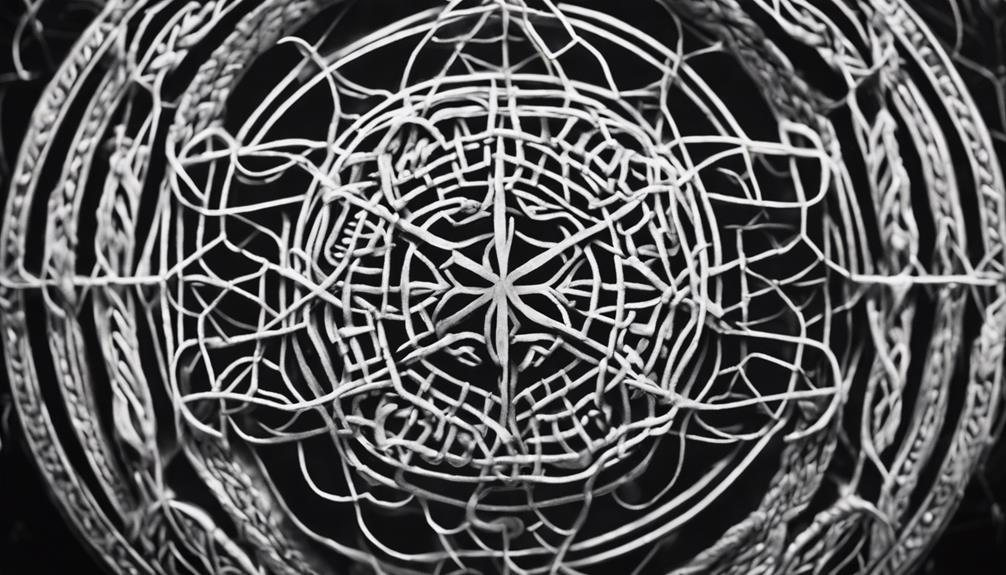
Drawing on ancient Norse mythology, the Web of Wyrd emblem intricately weaves together the threads of fate, embodying the interconnected nature of time and destiny. The Web of Wyrd symbolizes the cyclical nature of time and destiny, reflecting the past, present, and future within its complex design.
Here are some fascinating facts about this emblem:
- Symbolizes the interconnected tapestry of fate woven by the Norns in Norse mythology.
- Represents the concept of cause and effect, illustrating how present actions shape the future.
- Holds no written evidence from Viking times, adding to its mysterious allure.
- Embodies cosmic order and the weaving of individual destinies within the larger framework of fate.
The Web of Wyrd serves as a powerful reminder of the intricate balance between individual choices and the grand tapestry of fate in Norse belief. Its enigmatic design continues to captivate those intrigued by the gods of Norse mythology and the complexities of destiny.
Troll Cross Symbol
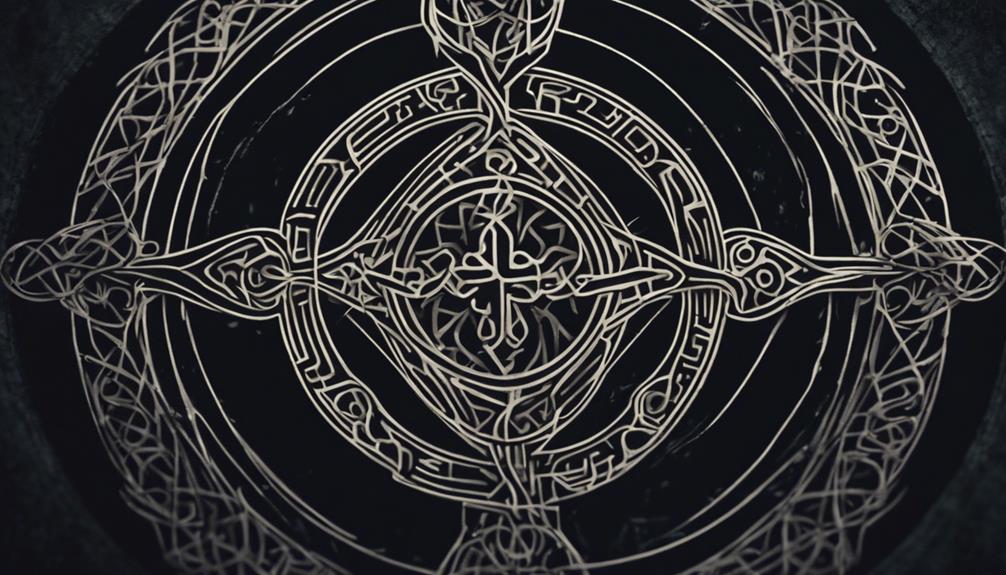
Ensuring protection and warding off malevolent forces, the Troll Cross symbol holds deep significance in Norse culture. Originating in Sweden, this symbol takes the form of the Othala rune and is believed to have the power to ward off evil spirits and protect against trolls in Viking folklore. Serving as a talisman of safety, the Troll Cross symbolizes security and acts as a shield against potential dangers.
Vikings valued the Troll Cross for its ability to provide a sense of security and safeguard individuals from harm. By carrying or displaying this symbol, they believed they could create a protective barrier around themselves, shielding them from malevolent magic and malicious entities. The Troll Cross symbolizes the strength and resilience of the wearer, instilling a sense of confidence and protection in the face of adversity. Embracing this ancient symbol, Vikings sought to navigate the challenges of their time with a sense of security and fortitude.
Frequently Asked Questions
What Is the Most Powerful Viking Symbol?
The most powerful Viking symbol is Thor's Hammer (Mjölnir), embodying thunder, lightning, and protection. It serves as a potent representation of strength and courage among Vikings, believed to bestow its wearer with Thor's protection and might in battle.
Wearing Thor's Hammer pendants was a common practice for invoking spiritual strength and invoking the god's shield. This enduring symbol transcends time and cultural boundaries, resonating with individuals seeking protection and valor.
What Is the Viking Lucky Symbol?
The Viking lucky symbol is the Vegvisir, a runic compass offering guidance and protection. It helps navigate rough weather and life's challenges, ensuring a secure journey.
Associated with luck, it guides individuals through unknown territories, physically and spiritually. Vikings trusted the Vegvisir for safe returns home, making it a cherished symbol of guidance.
What Is the Old Norse Magical Symbol?
The old Norse magical symbol is the Vegvisir, a runic compass aiding in navigation through tough times. Believed to guide one home safely on physical and spiritual journeys, it symbolizes protection and guidance.
Vikings revered the Vegvisir for its spiritual connections and relied on such symbols for influence and protection. The power of symbols was paramount in Viking belief, emphasizing the importance of understanding their meanings for enhanced safety and spiritual guidance.
What Is the Viking Eternal Symbol?
The Viking eternal symbol is the Helm of Awe (Aegishjalmur), embodying bravery and rune magic. It instills fear in foes, offering powerful protection in battle. Warriors don this symbol on shields and amulets for courage and strength.
This emblem strikes dread into adversaries, ensuring safety for its bearers. The Helm of Awe symbolizes the essence of valor and safeguarding in Viking culture.
Conclusion
As we've uncovered the meanings behind these top 10 Viking symbols, it's clear that each holds a powerful significance in Norse mythology.
But what if there are even more symbols waiting to be discovered? What hidden tales do they hold, waiting to be revealed?
Keep exploring the world of Viking symbols, and who knows what secrets you might unearth next. Stay curious and keep delving into the ancient mysteries of the Vikings.

